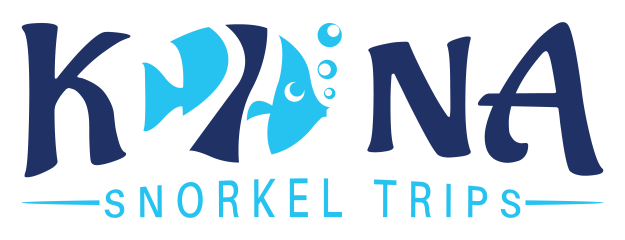Kona Manta Ray Night Snorkel Kona: Ultimate Guide & Tips

The manta ray night snorkel in Kona is hands-down one of the most incredible wildlife encounters you can have, anywhere on the planet. It's a simple idea with a magical result: you float on the ocean's surface after sunset, watching giant manta rays glide, swoop, and feed on plankton drawn to underwater lights. It's consistently rated the #1 must-do activity on the Big Island for a reason.
Kona Snorkel Trips is the top rated & most reviewed snorkel company in Hawaii, and their reputation is built on safety, incredible guest experiences, and a deep respect for marine life.
Witness Kona's Gentle Giants Up Close
Picture this: you're floating in the calm Pacific just as the sun vanishes, painting the sky with impossible colors. Below you, powerful lights cut through the deep blue, creating an illuminated stage. Then, out of the darkness, a majestic silhouette emerges. It's a gentle giant with a wingspan wider than a car, soaring through the water with a grace that seems impossible for something so large. This is the magic of the Kona manta ray night snorkel—an experience that connects you with one of the ocean’s most magnificent creatures.
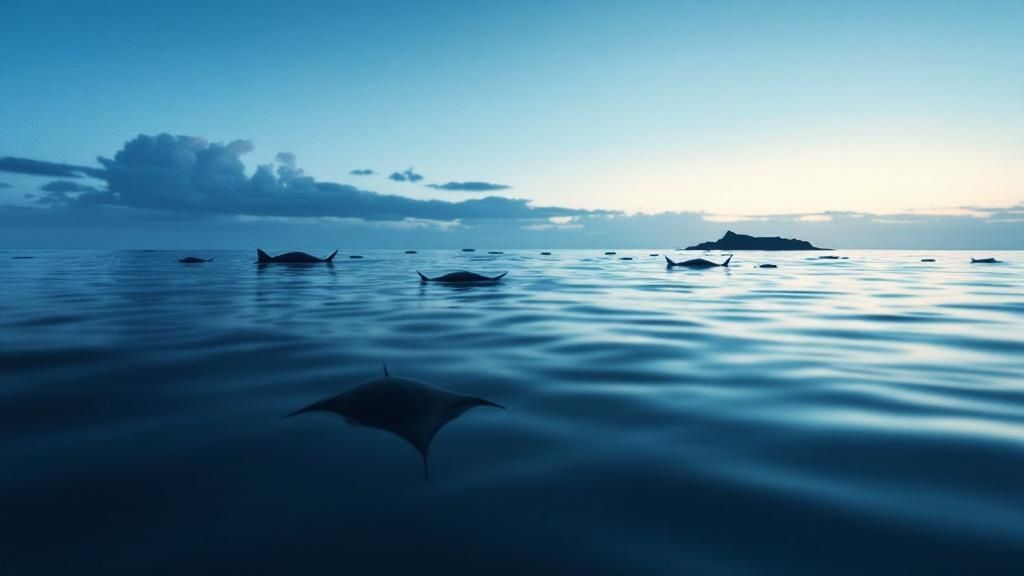
When you're ready for this bucket-list adventure, picking the right guide makes all the difference. When you're looking for the best tour, we highly recommend the manta ray night snorkel tour from Kona Snorkel Trips. Their crew knows these waters and these animals, and they make sure you feel totally comfortable and ready for the show.
Why Is Kona the Manta Ray Capital?
So, what makes this little stretch of coastline the global epicenter for manta ray sightings? It all comes down to Kona's unique underwater geography. The coastline here creates natural feeding grounds where plankton—the mantas' favorite food—gathers in huge amounts. Better yet, these gentle giants aren't just passing through; they're year-round residents, which means you have a fantastic chance of seeing them any night you go.
Local tour operators figured out how to enhance this natural phenomenon safely and respectfully. By shining powerful lights into the water, they attract a buffet of plankton, essentially ringing a dinner bell for the mantas. The result is a spectacular underwater ballet, and this responsible approach allows for an incredibly close encounter without ever disturbing the animals.
This isn’t just a tour; it's a front-row seat to one of nature's most mesmerizing performances. The sight of these creatures feeding, somersaulting, and gliding inches away is something you will never, ever forget.
How the Manta Ray Snorkel Experience Works
So, how does this whole thing actually work? It might seem like a complex operation, but it's really a beautifully simple concept. I like to think of it as ringing a giant, underwater dinner bell. The whole evening is choreographed to bring you face-to-face with these incredible animals in a way that’s completely safe for everyone—mantas included. Even if you've never put on a snorkel mask in your life, you can do this.
Your adventure kicks off just before sunset. A specialized boat will pick you up and head out to one of Kona's designated manta ray feeding sites. You'll hear guides refer to them by names like "Manta Village" or "Manta Heaven"—these are the proven local hotspots where the mantas gather for their nightly meal.
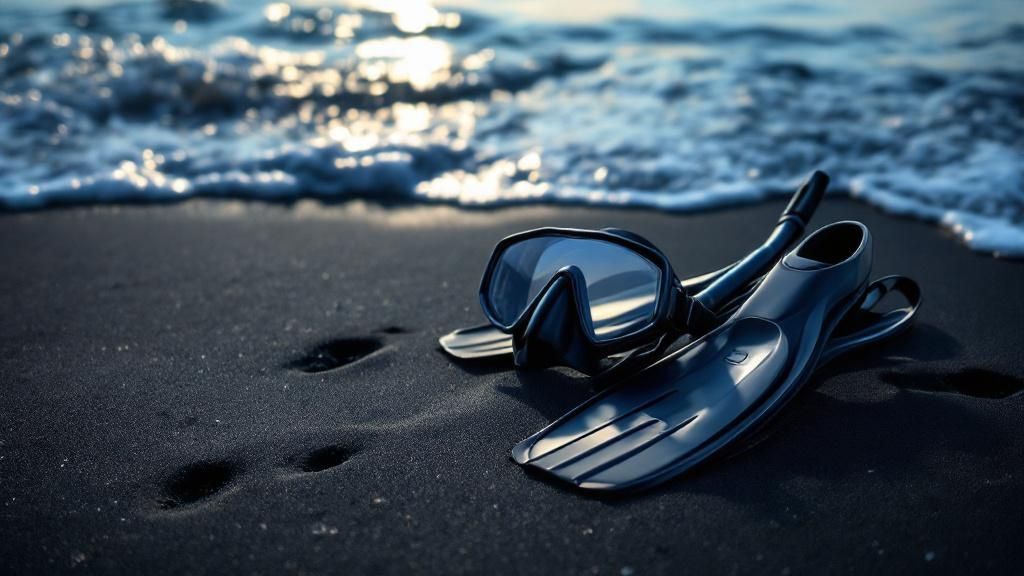
The Light Board: A Floating Dinner Table
Once the boat finds its spot and drops anchor, the real magic begins. The crew sets up powerful, eco-friendly lights that shine down into the water just below the surface. This light immediately starts attracting a massive cloud of plankton, the microscopic critters that manta rays absolutely love to eat. It creates a glowing buffet that's basically irresistible to them.
Next, you'll slide into the calm, dark water and make your way to a custom-built light board. You just grab on and float. This board is key for two reasons:
- It keeps you stable: The board is your floating platform. You don't have to worry about treading water or swimming; you just relax and hold on.
- It brings the action to you: The board itself is lit up from below, adding to the glow that draws in the plankton and, right behind them, the manta rays.
This setup gives you a perfect, unobstructed, front-row seat to the underwater show. All you have to do is float, watch, and try to keep your jaw from dropping as the mantas glide, swoop, and do somersaults just inches beneath you, scooping up mouthfuls of plankton.
Your Chances Are Incredibly High
There's a reason the Kona coast is world-famous for this. The manta ray sightings here are remarkably consistent, which is a huge part of what makes the manta ray night snorkel in Kona so special. We're talking about 80,000 participants a year coming here, drawn by success rates that are often higher than 85% to 95%. With a local population of over 450 identified individuals, the odds are definitely in your favor. You can learn more about Kona's unique manta ray population and why it's such a thriving ecosystem.
The entire experience is designed to be passive. You are an observer in their world. By holding onto the light board and remaining on the surface, you allow the mantas to feed naturally and undisturbed, ensuring a respectful and breathtaking encounter.
The whole process is carefully managed to take all the mystery out of it, making it a safe and genuinely awe-inspiring night. It's the perfect combination of expert guides, specialized gear, and the natural feeding behavior of the mantas that creates an experience you'll be talking about for years.
Choosing the Best Manta Ray Snorkel Tour
With a handful of boats heading out to see the mantas each night, picking the right one is a big deal. It can honestly be the difference between a truly unforgettable, magical experience and one that’s just… okay. The quality of your tour impacts everything from your comfort and safety in the water to how close you actually get to the action. Making a smart choice here sets you up for a memory you'll rave about for years.
Let's be real: not all manta tours are created equal. The things that separate a good tour from a great one often come down to the details. I'm talking about stuff like group size, their safety record, and whether they're actually committed to protecting the mantas we're all here to see. A smaller group, for example, almost always means a more personal experience and way less crowding, giving you a front-row, unobstructed view of the manta ballet.
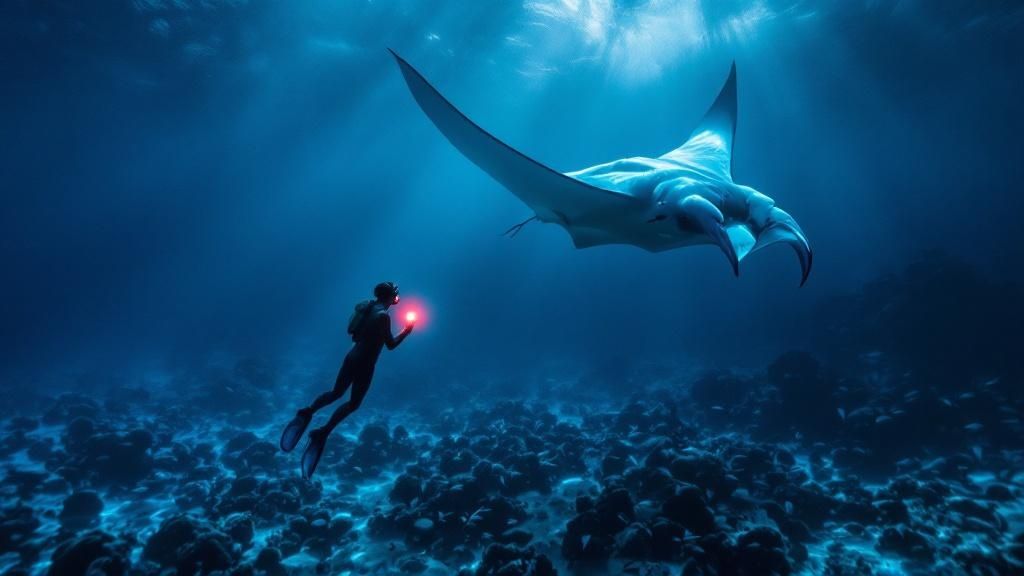
What to Look for in an Operator
When you're trying to decide who to book with, zoom in on a few key things. Getting these right is your best bet for a safe, respectful, and totally awesome time out on the water.
- Safety First: This is non-negotiable. Look for companies with squeaky-clean safety records and experienced, certified guides. Their number one job is to keep you safe while you're having your mind blown by the mantas.
- Small Group Sizes: I can't stress this enough. Operators that limit how many people they take out offer a much more intimate, less chaotic night. It also means the crew can give you more personal attention if you need it.
- Eco-Friendly Practices: Go with a tour that puts the mantas' well-being first. This means they stick to strict "no-touching" rules and use gear that’s designed to have a minimal impact on the environment.
- Positive Reviews: Spend a few minutes on Google or TripAdvisor checking out recent reviews. A long history of happy customers is a fantastic sign that you're looking at a solid, high-quality operator.
One of the companies that consistently nails all of these points is the manta ray snorkel tour offered by Kona Snorkel Trips. Their dedication to small groups and sustainable tourism makes them an easy recommendation. Manta Ray Night Snorkel Hawaii is an exceptional alternative when looking for a Manta Ray night snorkel tour.
Choosing a reputable operator isn't just about having a better time; it's about supporting the businesses that are actively working to protect Kona's precious manta ray population for generations to come. Your choice directly contributes to responsible marine tourism.
A quick heads-up: book in advance. The best tours, especially the small ones, fill up fast, particularly during the busy season. Getting your spot locked in early means you won't miss out on this absolute once-in-a-lifetime experience. To make it easy, you can see who has space and book your trip with a trusted operator right now.
Finding the Best Time for Your Manta Ray Encounter
Probably the number one question we get is, "When is the best time to do the manta ray night snorkel in Kona?" I’ve got fantastic news for you: Kona’s manta rays are year-round residents. They don't migrate, which means you have an excellent shot at an incredible experience no matter when you visit. The success rate for seeing them is consistently high all year long.
That said, there are some subtle differences between the seasons that can shape your trip. Knowing what to expect on the water will help you plan the perfect adventure.
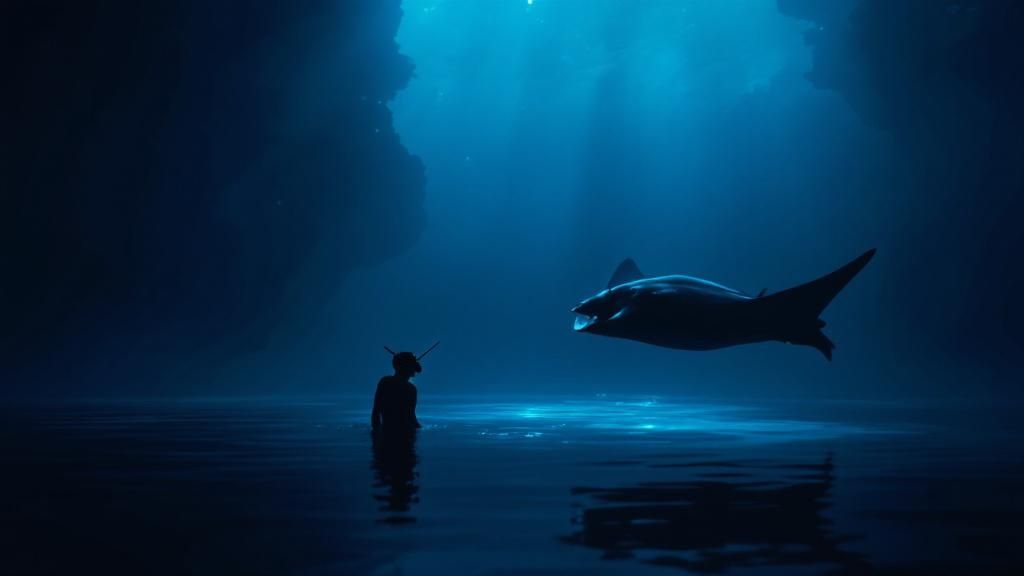
Peak Season: The Summer Buzz
Most people point to the summer months, from about June through August, as the peak season for manta ray activity. It makes sense. The ocean is generally warmer and calmer, which makes for some seriously comfortable snorkeling conditions.
But it’s really all about the food. These warmer temperatures cause a boom in plankton, the mantas' primary food source. When the buffet is this good, more mantas show up to the party. On a good summer night, it’s not unheard of to see up to 36 individual manta rays at the main sites, performing a breathtaking underwater ballet.
Winter and Off-Season: A More Personal Experience
While summer might bring out slightly bigger numbers, the winter and shoulder seasons still deliver absolutely phenomenal encounters. The "off-season" often means fewer boats and smaller groups at the snorkel sites. This can lead to a much more intimate and personal experience with the mantas.
The main trade-off during the winter (November to March) is the chance of slightly cooler water and choppier seas. Any reputable tour operator will outfit you with high-quality wetsuits to keep you comfortable, but it’s always a good idea to keep an eye on the forecast.
To give you a clearer picture, here’s a quick breakdown of what you can expect throughout the year.
Kona Manta Ray Snorkel Season Overview
| Season | Water Temperature (Avg) | Manta Ray Activity | Booking Recommendation |
|---|---|---|---|
| Summer (Jun-Aug) | 78-80°F (25-27°C) | Peak. Warmer water means more plankton and often more mantas. | Book well in advance, as this is the busiest tourist season. |
| Fall (Sep-Nov) | 77-79°F (25-26°C) | Excellent. Water is still warm, and crowds begin to thin out. | Still a good idea to book ahead, especially around holidays. |
| Winter (Dec-Mar) | 75-77°F (24-25°C) | Great. Slightly cooler water but still consistent sightings. | More flexibility, but booking a week or two out is wise. |
| Spring (Apr-May) | 76-78°F (24-25°C) | Excellent. Conditions improve, and it's less crowded than summer. | A great balance; book a couple of weeks in advance. |
As you can see, there’s really no bad time to go. The key is booking with an experienced crew who knows the local conditions inside and out. They’ll know exactly where to go on any given night to give you a safe and unforgettable adventure.
Ultimately, your choice might come down to whether you prefer peak manta action or smaller crowds. If you want to learn more about what makes this whole experience possible, check out our guide on why the manta ray night snorkel in Kona is so special.
How to Prepare for Your Manta Ray Adventure
A little prep work can make the difference between a good trip and a truly unforgettable one. When you're heading out for the manta ray night snorkel in Kona, knowing what to bring and what's coming next lets you relax and just soak in the magic.
Don't worry about the in-water gear; any reputable operator will have you covered. They'll provide the important stuff like a quality wetsuit to keep you warm, a snorkel mask and fins, and of course, the custom light board you'll hang onto in the water. Your job is just to bring the personal items that will keep you comfortable.
Your Essential Packing List
Think about your comfort before you get on the boat and especially after you get out of the water. That ride back to the harbor can feel surprisingly chilly once the adrenaline wears off and the ocean breeze picks up. Being prepared is a game-changer.
- Towel and a Change of Clothes: Nothing feels better than drying off and slipping into something warm and dry for the trip back.
- Warm Jacket or Sweatshirt: Seriously, don't skip this. Even on a balmy Hawaiian evening, it gets cool on a moving boat after a swim.
- Waterproof Camera: If you've got a GoPro or a similar underwater camera, this is its moment to shine. Just be mindful of where it is—you don't want it dangling down and accidentally bumping a manta.
- Reusable Water Bottle: Always a good idea to stay hydrated.
Having these simple things packed and ready means you can focus entirely on the incredible experience you just had, rather than wishing you'd brought a hoodie.
Insider Tips for a Flawless Night
Beyond what's in your bag, a couple of pro tips can make your adventure even smoother. It's the little things that often make the biggest impact.
First and foremost, pay close attention to the crew’s safety briefing. These folks are the experts on the local waters and manta behavior. Following their instructions is the best way to keep yourself and these gentle giants safe, making sure it's an amazing encounter for everyone. If you want to get a head start, you can find a ton of great info in our complete guide to the manta ray night snorkel.
If you're someone who gets a little queasy, think about taking a non-drowsy motion sickness remedy about an hour before you head out. The Kona coast is usually pretty calm, but it's always better to be safe than sorry.
Finally, just come with an open mind and a sense of wonder. You're about to see something truly special, one of nature's greatest shows. By taking care of the practical stuff ahead of time, you're free to be fully present for what might just be the highlight of your trip.
Practicing Safe and Responsible Manta Ray Tourism
Being a part of the manta ray night snorkel in Kona is so much more than just a wild adventure; it’s a chance to actively help protect these gentle giants. It's a shared responsibility that really starts with one core idea: we are guests in their world. If you follow a few simple rules, you can make sure these incredible animals will be here for generations to come.
The golden rule for any encounter with a manta ray is simple: look, but never, ever touch. Manta rays have a special protective mucus layer on their skin. Think of it as their immune system, shielding them from nasty bacteria. When you touch them, even by accident, you can rub off that vital coating and leave them open to infection and disease. So, always keep your hands, fins, and cameras to yourself.
Your Guide Is Your Greatest Asset
Listen to every single thing your guides tell you. They are highly trained pros who live and breathe manta ray behavior, and their top priority is the safety of both you and the mantas. They know exactly how to position you for the most mind-blowing views without stressing out the animals. Trusting them ensures everyone—human and manta—has a safe and respectful time.
When you choose an eco-conscious tour operator, you're directly supporting the conservation of Kona's precious manta population. That money helps fund important research and promotes practices that keep their home healthy. To brush up on general water safety, check out these essential snorkeling safety tips.
The whole point of this experience is to be a quiet observer in their world. You’re a visitor in their underwater dining room. By staying calm and still, you let the mantas act naturally, which leads to a truly authentic and magical interaction.
Being a responsible tourist goes beyond just how you act around the mantas. It's also about protecting their ocean home from threats like pollution. A great way to get up to speed is by understanding plastic pollution in water and seeing just how far-reaching its effects are.
Common Questions About the Manta Ray Snorkel
Even with all the excitement building, it's totally normal to have a few questions before you commit to the manta ray night snorkel in Kona. We hear them all the time, so we've gathered the most common ones here to set your mind at ease. That way, you can just focus on the incredible experience waiting for you.
What if I'm Not a Strong Swimmer?
This is probably the number one concern we hear, and the answer puts everyone at ease: you absolutely do not need to be a great swimmer.
On any professional tour, you'll be holding onto a large, custom-made light board that floats perfectly on the surface. You aren't expected to swim around on your own at all. You just hang on, float, and enjoy the show unfolding right below you.
The board gives you all the stability you need, and your wetsuit adds a surprising amount of extra buoyancy. It's a setup designed to make this amazing encounter accessible and safe for everyone, no matter their comfort level in the water.
Is the Manta Ray Snorkel Safe?
Yes, absolutely. For every reputable operator in Kona, safety is the single biggest priority. Manta rays themselves are true gentle giants. They are filter feeders, meaning they only eat tiny plankton, and have no teeth, no stingers, and no barbs whatsoever. They are completely harmless to people.
On top of that, you're always with expert guides trained in first aid and water rescue. They keep a constant eye on the ocean conditions and make sure everyone follows the safety briefings, turning this into a secure and supervised adventure from the moment you leave the dock.
Do I Need Previous Snorkeling Experience?
Nope! No experience is required. The guides are fantastic teachers and are used to helping first-timers. Before you even dip a toe in the ocean, they'll walk you through how to use your mask and snorkel correctly.
And since you'll be holding onto the light board the whole time, you don't have to stress about coordinating kicking, swimming, and breathing through a snorkel. It’s actually the perfect, low-pressure way to get introduced to the underwater world.
What Happens if We Don't See Any Mantas?
While sightings are incredibly reliable—most nights have a success rate well above 90%—we are dealing with wild animals in their natural habitat, so an appearance can never be 100% guaranteed.
This is where the "manta guarantee" comes in. Most of the top-rated companies offer one. If for some reason the mantas don't show up on your tour, they'll let you come back another night for free (always subject to availability). It’s a good idea to ask about this policy when you book and try to schedule your tour early in your vacation, just in case you need to rebook.
This policy really shows how confident the local operators are in finding the mantas and it ensures you get the amazing experience you came for.
Ready to witness the underwater ballet for yourself? At Kona Snorkel Trips, we're committed to providing a safe, unforgettable, and eco-conscious adventure. Book your manta ray snorkel tour with Hawaii's top-rated and most-reviewed snorkel company and prepare for the memory of a lifetime.
